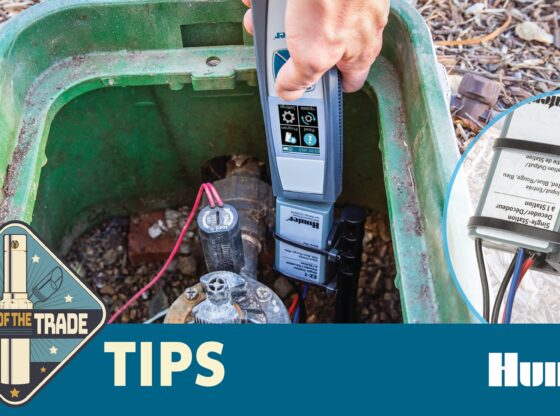Lots of irrigation industry and government people talk about water conserving irrigation systems. It begs the question, what does water conserving irrigation look like?
The two most important factors for an irrigation system to be considered “conserving” are high distribution uniformity (DU) and site based scheduling. Other factors help too but are meaningless without good uniformity and scheduling according to current site based plant water requirements.
High Distribution Uniformity
Simple explanation, the irrigation system applies a uniform application of water over the intended area. Whenever poor distribution exists the user will have to increase run time, thus water applied, to get enough water in the dry area(s). Obviously, applying more water means water is wasted.
Good distribution uniformity is achieved by choosing the right sprinkler and nozzle selection, laying them out at the most advantageous distance, and delivering the right quantity of water to each sprinkler at, very importantly, the right pressure (hydraulics).
Sprinkler Selection
Sprinklers and nozzles are easy to select. Manufacturers have done a good job of providing several viable options. Some claim certain sprinklers have better DU. All professional grade sprinklers can be laid out to provide high DU. The brand or model is almost irrelevant as long as a particular sprinkler is spaced correctly. All sprinklers have their “sweet spot” where they provide their best DU.
Sprinkler layout is not hard. As long as a head-to-head layout is achieved uniformity should be pretty good. Common issues are spacing too far and improper nozzle selection. Any good designer or contractor should be very keen on sprinkler layout.
The system hydraulics can be tricky. Many problems arise that cause DU to suffer and a lot of folks are not using the right equipment or even aware of the issues. Fortunately we have products to help alleviate hydraulic problems. Good sprinklers properly spaced must have good hydraulic conditions to perform well.
Finding the Right Pressure
The key issue is to insure the right pressure is being delivered at each sprinkler. Ideally every sprinkler on a zone will be working at the same operating pressure. And that pressure will be the point for optimum sprinkler performance. Rarely in a typical system do you find that to be the case.
The best solution for pressure management are pressure regulating sprinklers. Consider a mid-size turf rotor that operates best at 45 psi. If the rotor has pressure regulation built in then all a designer has to do is insure there is at least 45 psi delivered to each sprinkler. The excess pressure will be eliminated at each sprinkler by the pressure regulator. In that case all sprinklers will do the same job at their best operating pressure.
Water Conserving Tip: Use pressure compensating sprinklers! They cost a $1 or so more, but the pay back is fast.
Assuming a fairly competent designer, all the other criteria for good hydraulic performance is relatively easy to accomplish (pipe sizing, pipe routing, zone flow rates, elevation changes, etc). Coupled with normal hydraulic design principals pressure compensating sprinklers will guarantee good DU.
Low Volume Irrigation Product
Generally, use of low volume (or drip) irrigation will save water. Not so much for the turf areas, but definitely for the planting beds and ornamental plant material. Attempting to apply the right amount of water in a planting area with overhead irrigation is difficult.
Canopy blockage, odd shapes, and differing plant materials makes good application almost impossible with overhead. Low volume allows easy alternative and flexible application with very little wastage.
Water Conserving Tip: Use low volume products in planting beds!
Plant Water Scheduling
Currently in my area an irrigation system is started up in April/May, programmed to irrigate as if it was July (the peak demand), and left that way until it’s shut down in October. The result is applying about 30% more water than is needed in a normal season. Given a season with above normal rainfall and the wastage is even greater.
About 5 years ago controllers began hitting the market that use some sort of on site sensor to tell the controller how much water the plant material on that site needed. At first they were expensive. Now they cost $200-$500 more than old style controllers.
ET Rate Controllers
Most use sensors to measure on site weather data and the controller then calculates an Evapo-transpiration rate (ET) to use for scheduling. Some use soil moisture sensors. Such controllers are not that expensive and are relatively easy to install and operate.
Water Conserving Tip: Use an ET based irrigation controller! (Soil moisture sensing equipment is not quite ready for prime time. Maybe soon . . )
An ET based controller does require more time to set up and does best with fine tuning of localized micro climate data. But once set-up and fine tuning is completed it takes over and operators don’t have to do much.
Consider ET based controllers to be like a thermostat controlling your air conditioning. You tell it what temperature you want and it runs the AC as needed to keep it there. Once the ET controller is set, it runs the system to meet the plant water requirement with little further input from you.
Results are about 30% or more water savings in my area. At $2.75 per CCF for water, that equates to about $1,100 per year savings per irrigated acre of turf grass. Not bad!
So, achieving a water conserving irrigation system will cost a little more, but typically will pay for itself within a season or two. After that the savings stay in the pocket of the owner. Well worth consideration compared to old fashioned wasteful systems. And you can say you are “Green”.











